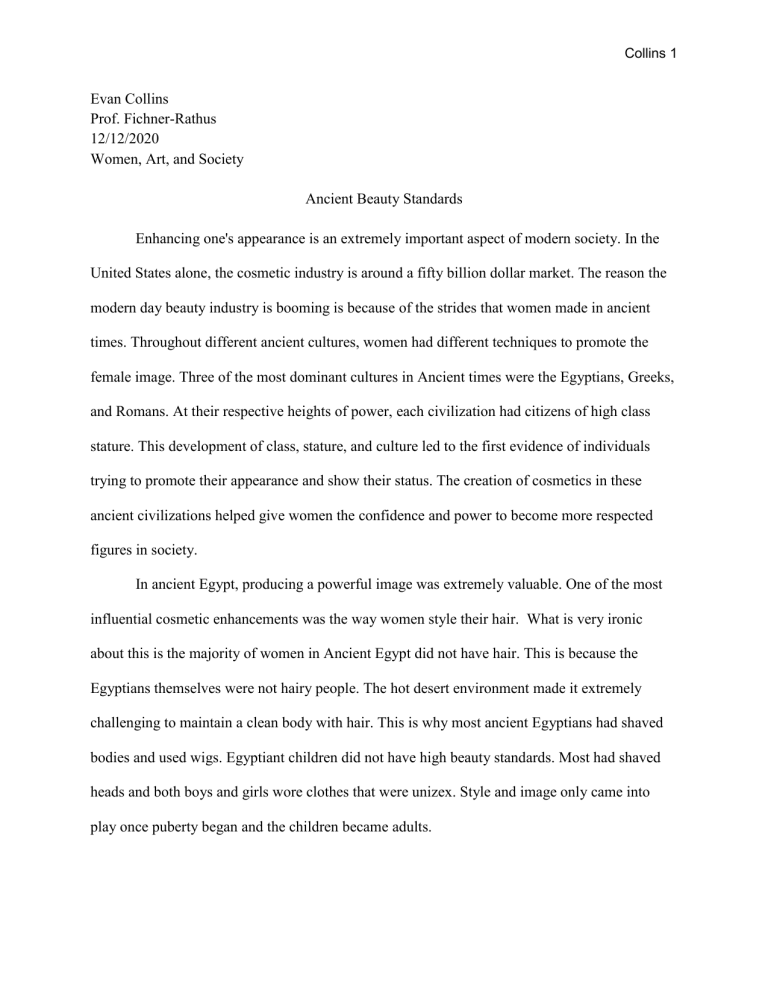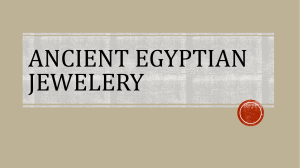
Collins 1 Evan Collins Prof. Fichner-Rathus 12/12/2020 Women, Art, and Society Ancient Beauty Standards Enhancing one's appearance is an extremely important aspect of modern society. In the United States alone, the cosmetic industry is around a fifty billion dollar market. The reason the modern day beauty industry is booming is because of the strides that women made in ancient times. Throughout different ancient cultures, women had different techniques to promote the female image. Three of the most dominant cultures in Ancient times were the Egyptians, Greeks, and Romans. At their respective heights of power, each civilization had citizens of high class stature. This development of class, stature, and culture led to the first evidence of individuals trying to promote their appearance and show their status. The creation of cosmetics in these ancient civilizations helped give women the confidence and power to become more respected figures in society. In ancient Egypt, producing a powerful image was extremely valuable. One of the most influential cosmetic enhancements was the way women style their hair. What is very ironic about this is the majority of women in Ancient Egypt did not have hair. This is because the Egyptians themselves were not hairy people. The hot desert environment made it extremely challenging to maintain a clean body with hair. This is why most ancient Egyptians had shaved bodies and used wigs. Egyptiant children did not have high beauty standards. Most had shaved heads and both boys and girls wore clothes that were unizex. Style and image only came into play once puberty began and the children became adults. Collins 2 In Egyptian society, wigs were an extremely important symbol of status. They were typically made of black hair, and were very thick. They also had jewellery or ornaments that were braided into them. What is so special about Egyptian wigs is that for women it was a symbol of power. Since the wigs were so intrucut, it meant that one would need the resources in order to maintain the wig. Women that were well off had the ability to have complex wigs with lots of braids and jewelry. The most powerful women had enough resources to maintain healthy natural hair. What is important about this is for women, the hair was an erotic symbol. Long, healthy looking hair helped women become figures of sexuallity and fertility. Having long wigs also helped hide age. This is because individuals were able to cover their gray hair with the dark black wigs. There were multiple styles of wigs that ancient Egyptian women had the ability to wear. What is most interesting about this is there is a lot of evidence that supports that each wig represented a different status for the woman that was wearing it. The main hairstyle used was called the tripartite style. In the first hairstyle, it was divided into three bundles where two of them were on each side and one was in the back. This left the women’s shoulders exposed. Another hairstyle was styled so it was not in separate parts and it draped over the shoulders. Daughters of people who were well off in Egyptian society would wear tresses and ringlets in their hair to shape it and have a thin ponytail in the back. This hairstyle was never worn by mothers, it often meant that a woman was no longer a child, but they were still not married. Women with these hairstyles also typically wore clothing that was more revealing, than women that were the first tripartite style that was described. Wigs for ancient Egyptian women were an extremely important cosmetic enhancement for them because they helped promote the female sexual image, and give them status in society. Collins 3 In addition to using hair to enhance their appearance, another cosmetic that ancient Egyptian women focused on was makeup. In Egyptian society, makeup was also extremely important and was used by both men and women. The main purpose of wearing the makeup was it was believed that the makeup gave them the protection of the gods Horus and Ra. Makeup such as the dark liner that typically went around their eyes, also served as a deterrent of the sun's harmful rays in the desert. Egyptians wore a significant amount of makeup which was originally for religious purposes. This would slowly turn from being more religious to being more of a status and symbol of beauty, similar to the wigs they wore. Similar to the ancient Egyptians, the ancient Greek culture emphasized a similar importance on the use of cosmetics. One of the main differences between the Greeks and Egyptians was that the Greeks did not use wigs like the Egyptians did. There was not a need to do this because the meditaranean environment was not as intense as the Egyptian desert biome was. The Greeks did use hair dyes to either dye their hair lighter or darker. This was done to help hide age. The dyes to make hair darker were extracted from leeches and marinated in wine, while the dyes to make hair lighter was a mixture of beech wood ash and goat fat. One thing that was really important to Greek women was perfume. These good scents were a symbol of status in society and were also used for pleasure and seduction. The perfumes had an oil base and usually were a thick paste. Everything the Greeks used for cosmetics was made from exotics natural ingredients. Similar to the Egyptians, the Greeks used eyeliner and did their eyebrows. The Greeks typically went light on their eyeliner, which was made from a kohl powder which was made up of soot, antimony, saffron or ash. Women would also color in their eyebrows. While Egyptian womens eyebrows were typically more pronounced, sharp, and thick, the Ancient greek women usually did their eyebrows thinner. They were not very long in length Collins 4 and often women had their eyebrows connected at the center. This was seen as a sign of beauty and status. What is interesting about the culture for makeup in Greece is what happened to the idea of cosmetics once it became mainstream. There were many philosophers and writers that wrote how makeup was a “trick” used by lower class women and prostitutes to hide their looks. Though this is what some men believed, makeup in ancient Greece still remained a delicacy for status, that all women could use. The final culture that will be discussed is the Ancient Romans. The Romans had a very strict aesthetic that women were supposed to fulfil which was ultimately influenced by the Greeks and Egyptians. Roman women had an intensive skin care routine, which used natural ingredients to keep them healthy. Shaving became popular in Rome after 300 BCE. Once it became mainstream, it was common that women were not supposed to have a single hair on their body. They regularly plugged their hairs and smoothened their skin. What is interesting about this is even though Ancient Egyptians often shaved their bodies, there is evidence they did keep hair in pubic regions that were not often shown. This was found on ancient mummies in tombs. Another way the Ancient Romans took care of their skin was by using Lomentum, which was a substance rubbed on the skin which would reduce wrinkles. One of the most noticeable cosmetics that Roman women used was chalk to whiten their skin. This was because it showed and symbolized high status in society. If a woman had extremely pale skin, that showed that she was unburnt and spent most of her time inside. This would lead people to think that she was able to live a lavish lifestyle, because she had the resources such as slaves to do work for her, while she stayed inside. The mixture for this whitening powder was more complicated than it seems. First, barley groats and wetch were Collins 5 mixed with a large quantity of eggs. Then the mixture was dried and then grinded in a stone mill. The powder was then collected and poured through a sieve to get the proper consistency. Then narcissus bulbs were added and crushed into the mixture. This fine powder was then rubbed into the skin and gave women the pale complexion that they desired. Greek women would also apply white cosmetics to pale their skin. The Egyptians did not apply this kind of makeup to their skin because it would not protect them from the sun. What stands out about Roman beauty compared to the Egyptians and Greeks was that the Romans did not use as much makeup. They focused more on the color of the skin and smoothness and healthiness of it. Makeup and other cosmetics have been an extremely important aspect of society, ever since the beginning of civilizations. Once large powers such as the Ancient Egyptians, Greeks, and Romans developed, there was a need to display status and prestige. Cosmetics were one of the best ways for a woman to display her power and image in that society. Women were able to utilize wigs and makeup to show their importance and project the female image. In addition to this, they were also able to utilize skin scare products to show their natural beauty as well. The usage of cosmetics that was used by the Egyptians, Greeks, and Romans had ultimately inspired the cosmetic industry today. Today, makeup, hair, and skin care products are marketed to women to build their confidence and enhance their outer beauty. Since the explosion of these ancient civilizations, cosmetics for women have been a staple in status and beauty. It is insane to realize that much of the makeup techniques and looks that are used today, are based off of the images and roles that powerful and confident women were able to portray in ancient times. Collins 6 Works Cited Cartwright, Mark. "Cosmetics in the Ancient World." Ancient History Encyclopedia. Ancient History Encyclopedia, 06 Sep 2019. Web. 13 Dec 2020. Jasiński, J. (2019, May 04). What beauty was appreciated by Romans? Retrieved December 13, 2020 Robins, Gay. “Hair and the Construction of Identity in Ancient Egypt, c. 1480-1350 B.C.” Journal of the American Research Center in Egypt, vol. 36, 1999, pp. 55–69. JSTOR, doi:10.2307/40000202. Accessed 13 Dec. 2020. Wilner, Ortha L. “Roman Beauty Culture.” The Classical Journal, vol. 27, no. 1, 1931, pp. 26–38. JSTOR, www.jstor.org/stable/3290598. Accessed 13 Dec. 2020.


